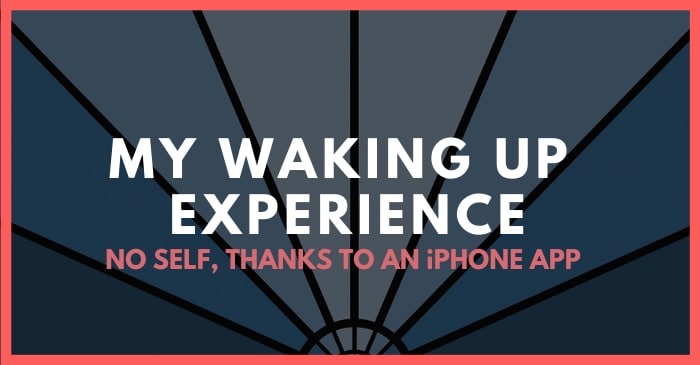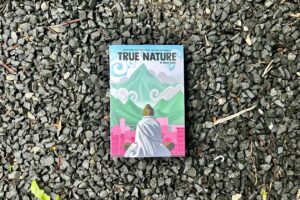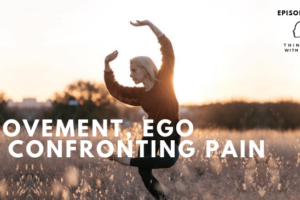In the Buddhist teaching, there are three primary characteristics of existence: impermanence, unsatisfactoriness, and no-self. I’ve experienced these characteristics to varying depths and degrees in my practice of Vipassana, a body-scanning meditation technique and a Pali word meaning “to see clearly,” but no-self is far and away the most elusive insight of the bunch.
No-self (also sometimes stated as not-self) is an idea, which can also be directly experienced, that “the self” is a conceptual illusion—that I do not exist in the way I think I do. The seat or center of attention cannot be pointed to and therefore does not exist. Sure, my brain and body exist at the physical level, but “me”, “mine” and “I” are closer to unclear, conceptual abstractions. The no-self insight seeks to answer the question: who am I? And apparently, the moment one goes looking for the answer, they’re bound to find… nothing. 🙂
It’s an important insight because “the self” is the root of our suffering. So much of our daily turmoil is done to preserve, express, and enhance our self-image. And what a relief it would be not only to understand but to directly experience that the self never existed and needed no unnecessary bolstering in the first place.
No-self is unlike the other two characteristics of existence, which are pretty straight-forward (impermanence = nothing lasts, unsatisfactoriness = the mind wants that which it does not have and does not want that which it has), and thus becomes a difficult idea for many of us in the West to comprehend intellectually, much less experience directly. And the latter is the key to its understanding.
Until a couple of months ago, I found no-self to be the trickiest of insights. Even in deep states of concentration and moments of body disillusionment, I felt myself identifying as an observer in possession of attention. And how could there be no-self if I’m the observer? The mind remained, but instead of growing disheartened or discouraged by this process, I developed a growing curiosity for this elusive no-self insight.
That brings us to about two months ago when, in however small a way, I first tasted this evasive experience.
MY (LIMITED) EXPERIENCE WITH NO SELF
It began with an iPhone/Android app called Waking Up, the brainchild of neuroscientist, meditator, and public intellectual Sam Harris. I tapped into the app as a skeptic of most guided meditation apps but since Sam was once a Vipassana meditator, I was curious what he had to teach that would be different from any good ole 10-day Vipassana course.
Needless to say, the app pleasantly surprised me. Here’s what I found to be insightful—I hope it’s as useful to you on your journey as it has been on mine.
THE WAKING UP APP
Firstly, the app’s content is a mix of lessons and guided meditations but the contextual gem in helping me understand the app’s origin and purpose was the lesson entitled “Gradual vs. Sudden Realization.”

Sudden screenshot from the Waking Up iPhone app.
It’s in this lesson that Sam recounts the story of his experience with Vipassana meditation, a technique with which he grew frustrated over the years and led him to seek new techniques. Sam’s personal critique of Vipassana goes like this: it is a path of gradual awakening, one in which the practitioner gradually works their way through various insights, toward subtler and subtler realities until experiencing the subtlest of all realities—enlightenment. Vipassana by no means rules out sudden awakening, although it generally runs counter to the practice’s paradigm as it’s well accepted the path takes many years, if not lifetimes of steadfast effort and diligent practice toward this pursuit until one’s time ripens.
Frustrated with his enlightenment progression on the Vipassana track, Sam embarked to Nepal where he encountered a practice that better suited his seeking and flipped his gradual meditative paradigm. As Sam puts it: “[he] went to shed his ego but found none existed.”
ENTER DZOGCHEN
The practice Sam encountered which first delivered him this insight is called Dzogchen (Sam pronounces this as zoeg-chen). Listening to the app was my first time hearing of Dzogchen and I have no direct experience with it apart from Sam’s teachings and my intellectual studies, so take this with a grain of salt, but based on Sam’s explanation, in combination with what I’m experiencing, Dzogchen is a non-dual meditation technique delivered in what’s called the pointing out instruction, rooted in the realization that the no-self insight is actually available on the surface level of awareness, including during everyday mundane moments. Sam reinforces this in his guided meditation sessions through commands like “arrive suddenly” and “arrive all at once.”

One (without a Second*) example of a nondual meditative practice. (* = nondual jokes)
As a Vipassana practitioner, I find these types of commands new, interesting and useful. I don’t believe Sam is very “deep” in his concentration when he’s experiencing no-self. I say this from a dualistic perspective where there are various degrees, depths and intensities to which one can glimpse insights. On the path of duality, a surface-level no-self experience such as this must not be confused with nibanna, or complete cessation of suffering.
But that’s sorta the point of Dzogchen. Depth isn’t required to glimpse the no-self insight. In non-dualistic teachings, depth and surface are dualities and thus superficial. Rather, the awakening experience is available right here, right now, as it is. You don’t have to get any closer to anything. After one has received what’s called the pointing out instruction, one has already arrived. Therefore, in the Dzogchen worldview, the path is both separate from enlightenment and at the same time encompassing of it. Note the limitations of language when it comes to non-dualistic teachings. Language is inherently dualistic so the linguistic territory is difficult to navigate non-dualistically and accounts for the mind-boggling parables, riddles and koans found in such traditions. In Dzogchen, there is no self who is suffering in the first place so there is no self to purify.
Initially, I believed this whole Dzogchen thing ran in opposition to my dualistic belief that glimpsing insights requires lots of work. And I do still think work is required, but this doesn’t necessarily place Dzogchen in opposition to Vipassana or any other gradual awakening practice. There’s a grain of truth to extract from every teaching. In essence, both are correct and neither should be discounted. Per the Dzogchen teaching, I am finding some piece of this no-self insight to be available at the surface and thus my paradigm is having to shift accordingly. Perhaps Dzogchen has something to learn from Vipassana and vise-versa.
I’m not claiming to have experienced enlightenment or even having arrived at any particular station along the path. Instead, I’m merely stating this app has been useful in showing me the tools to better understand and glimpse no-self, if only at the supposed surface level.
For instance, back to this problem of a meditator feeling themselves identifying with the observer in possession of attention. Whereas the Vipassana approach might continue to observe the body’s sensations, in Dzogchen, one turns attention (which I perceive as sensations) back onto itself in an attempt to observe the observer in space or to locate the feeling of observing. The moment I turn awareness back on itself, it’s confusingly evident there’s no self or seat or center of consciousness to observe. There, I simply rest in that space. The work shifts to resting with awareness rather than sharpening with great effort. The observer (or those sensations associated with being an observer) then become another feeling encompassed within the grander realm of consciousness. I hope that made sense, ha. It’s a slightly different way to work with attention—it feels relaxing, wider and at a meta-level of awareness compared to digging in the field of sensation, a step toward what Buddhists might call Right Effort.
Another small/large difference between the practices (at least the way I was practicing) is that catching oneself while lost in thought is scored as something of a loss in mindfulness, a reason to strengthen your awareness and then “try again” or “return” to the practice. In Dzogchen, the thought which you were rolling in can serve as yet another tool to reinforce the understanding of no-self through either the observation of the thought’s origin (where did that thought come from?), its creator (who thought that thought?), or its exit (where did that thought go?), without mentally verbalizing these questions; mere observation.
By no means am I trying to discount the practice of Vipassana. To me, it remains an invaluable tool and I’ll continue my practice headstrong. In speaking with my long-time Vipassana meditator friend Bradley about these practices, he brought up a valuable point: that each path of meditation and most spiritual paths have built within them the same goal—the removal of suffering and ultimate liberation. How one reaches this end can be accomplished by entering through a variety of doors, in the case of Buddhism those doors being: the door of impermanence, the door of suffering, or the door of no-self.
Simply put, I see Dzogchen as another door leading to the same end.
All that said, I have not (yet) received the pointing out instruction, so take everything I’m saying with a grain of salt and feel free to call me a fool. Until then, I believe that these practices can be cross-trained in the same manner an athlete might for strength but for insights. Whether you enter through the door of impermanence, unsatisfactoriness or no-self, may you find a way out of your suffering. I’m stoked about the whole path and inspired to work.
I was once hesitant to recommend meditation apps, but I’ve found Sam’s guidance to be a wonderful supplement to a self-led practice. Join me on this journey either by signing up for a vipassana course, downloading Waking Up app (currently $15/month), testing this for yourself and engaging in this dialogue with me. I’m not affiliated with Sam or his app but I invite you to invest in your mind. It is truly all we have to offer at each moment. And maybe, through our journeying, we’ll find there was no mind to invest in the first place. 🙂
Thanks for reading. If you enjoyed this post, please consider subscribing to my blog.
Love,
David
If you enjoyed this post, you might also like these blog posts:
- The Best of the Waking Up App | Conversations About Meditations
- My Experience with Vipassana Meditation: Four Years of Insights, Hindrances & What’s Next
- How to Prepare for a Weekend Solo Retreat
- The Story Behind True Nature: What I Learned About Love & Enlightenment
- Real Happiness: Understanding the Root of Suffering
- How to Protect and Cultivate Attention





4 Comments
Leave your reply.